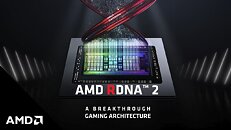Raevenlord
News Editor
- Joined
- Aug 12, 2016
- Messages
- 3,755 (1.17/day)
- Location
- Portugal
| System Name | The Ryzening |
|---|---|
| Processor | AMD Ryzen 9 5900X |
| Motherboard | MSI X570 MAG TOMAHAWK |
| Cooling | Lian Li Galahad 360mm AIO |
| Memory | 32 GB G.Skill Trident Z F4-3733 (4x 8 GB) |
| Video Card(s) | Gigabyte RTX 3070 Ti |
| Storage | Boot: Transcend MTE220S 2TB, Kintson A2000 1TB, Seagate Firewolf Pro 14 TB |
| Display(s) | Acer Nitro VG270UP (1440p 144 Hz IPS) |
| Case | Lian Li O11DX Dynamic White |
| Audio Device(s) | iFi Audio Zen DAC |
| Power Supply | Seasonic Focus+ 750 W |
| Mouse | Cooler Master Masterkeys Lite L |
| Keyboard | Cooler Master Masterkeys Lite L |
| Software | Windows 10 x64 |
The image upscaling wars keep grassing, with AMD and NVIDIA claiming as many integrations as possible for their respective FSR (FidelityFX Super Resolution) and DLSS (Deep-Learning Super Sampling) technologies in a bid to achieve maximum market share for their respective technologies. While the entire world was now focusing on Intel's own addition to the image upscaling wars with its XeSS (XE SuperSampling) tech, AMD is apparently looking to introduce a new upscaling tech as early as January 2022. Enter Radeon Super Resolution (RSR).
Right off the bat, do not expect RSR to be AMD's answer to the perceived image quality advantage of NVIDIA's deep-learning-powered DLSS compared to AMD's more open (and cross-hardware compatible) FSR. Instead, AMD seems to be targeting RSR as a game-agnostic upscaling solution that's based on FSR, but which can be enabled at the Radeon driver level for any game that supports exclusive full-screen rendering. AMD is seemingly moving its image upscaling technique further up in the graphics pipeline, which should impact upscaling quality (as there's less information for the image upscaler to work with). What this does enable, however, is an agnostic solution that can be deployed in any game - provided you're rocking one of the two rumored architectures that will support RSR (RDNA and RDNA2, in the form of AMD's RX-5000 and RX-6000 series). Considering the expected release of RSR, it's likely that AMD will have an official announcement around CES 2022, despite the fact that the company won't be physically present due to COVID-19 and logistics concerns.

View at TechPowerUp Main Site
Right off the bat, do not expect RSR to be AMD's answer to the perceived image quality advantage of NVIDIA's deep-learning-powered DLSS compared to AMD's more open (and cross-hardware compatible) FSR. Instead, AMD seems to be targeting RSR as a game-agnostic upscaling solution that's based on FSR, but which can be enabled at the Radeon driver level for any game that supports exclusive full-screen rendering. AMD is seemingly moving its image upscaling technique further up in the graphics pipeline, which should impact upscaling quality (as there's less information for the image upscaler to work with). What this does enable, however, is an agnostic solution that can be deployed in any game - provided you're rocking one of the two rumored architectures that will support RSR (RDNA and RDNA2, in the form of AMD's RX-5000 and RX-6000 series). Considering the expected release of RSR, it's likely that AMD will have an official announcement around CES 2022, despite the fact that the company won't be physically present due to COVID-19 and logistics concerns.

View at TechPowerUp Main Site


 .
.


